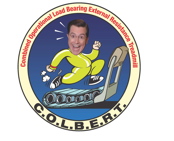The DIY Podcast topic module about fitness explains that space station crew members use treadmill exercises to maintain bone mass, cardiovascular fitness and muscle endurance. The device that’s mentioned and demonstrated is the Treadmill Vibration Isolation System, or TVIS. Now, a new treadmill to go along with TVIS has been added to the station, and you may want to include it in your classroom’s podcast about fitness.
COLBERT, the world’s most famous treadmill, was transferred to the station in September during the STS-128 shuttle mission. The Combined Operational Load Bearing External Resistance Treadmill, or COLBERT, is named after Comedy Central’s Stephen Colbert of “The Colbert Report.” NASA chose the acronym COLBERT after the television comedian received the most votes in an online NASA poll to name a space station node. NASA opted to name the node Tranquility, but named the treadmill after Colbert.
COLBERT (the treadmill, not the comedian) has a maximum speed of 12.4 mph, which is faster than the Olympic 100 meter race record. Crew members usually run about 4 to 8 mph. The COLBERT design allows ground experts tracking crew health in orbit to create individual exercise prescriptions and uplink them to the crew as a profile.
The following links to images, video and background information will be helpful if your students want to include COLBERT in their fitness production.

Official COLBERT PATCH

COLBERT decal on the treadmill
Stephen Colbert’s inspirational message video
Do Tread on Me
COLBERT Ready for Serious Exercise
Announcement on “Colbert Report,” Treadmill Named COLBERT
